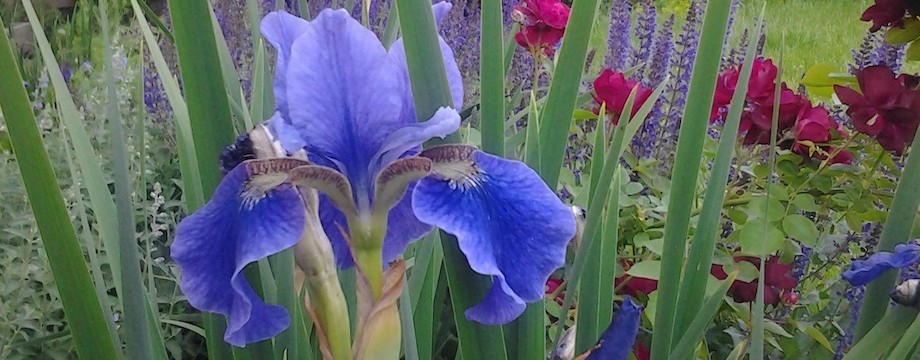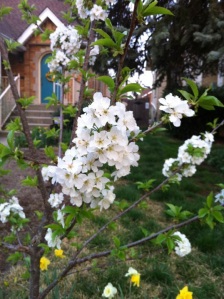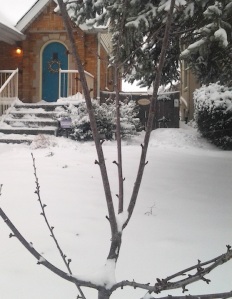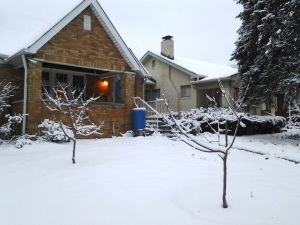The garden year
First Day of Spring…
…my dead can.
You may have noticed that it’s cold. Like freeze your nose hair off cold. I worked in the field on Monday and part of Tuesday, and that wind went through me like buzz saw.
Last year this time, the daffodils were blooming and my cherry tree was in full bloom. Today? Snow flurries. The ground is so hard that cleaning out beds is a major chore; the dead leaves are frozen solid.
I just can’t get motivated to get out into my own garden to knock down the last of the rye or turn the compost,and the soil’s too cold for spring planting. Instead, I am mostly spending my free time making garden lists, cruising Pinterest, and following the example of my cats:
Peas and Potatoes by St. Patrick’s Day…
Last year, we had a series of 80 degree days in March. This year, we’ve had snow, sleet, freezing rain, regular rain, and mud. It’s freaking cold, and it’s also depressingly grey.
St. Patrick’s Day has come and gone, and I did not get the peas or potatoes in. Why? Three reasons:
1. I spent most of the weekend talking about gardening at the Indiana Flower and Patio Show and the Indy Winter Farmers Market.
2. I just took down my rye cover crop last week. Rye can inhibit germination of newly planted seeds, so I’m giving it another week before I plant in beds that had the rye.
3. The soil’s still a bit too cold. For peas and potatoes, the soil temperature should be at least 40 degrees; 45 degrees is better. Mine’s still just a bit colder than that.
What do you mean, how do I know? I stuck a meat thermometer in the dirt. Don’t judge me; I washed it off after.
I’ll get these Irish-y crops in the ground next weekend, provided we don’t have yet another March snowstorm.
In the meantime, enjoy this completely unrelated picture of pansies filling the back of the truck last year:
Last (I hope) Winter Blast
So I’ve sown leeks, eggplants, and peppers inside. I’ve pruned the fruit trees and raspberry canes. I’ve got a planting plan and I’m not afraid to use it. I am ready for spring.
Then this happened.
A thick, fluffy, wet layer of snow, with a soupçon of ice underneath. Fortunately, I was able to shovel the walk pretty quickly and then take my trusty phone out for a few snaps.
Pa Ingalls taught me that a late snow is poor man’s fertilizer. It brings nitrogen down from the atmosphere to the ground, and nitrogen is the element that has the most impact on vegetative growth.
Of course, Pa plowed that snow into his fields. I am without a plow and team of oxen. So I’m just going to hope that the snow does my plants some good.
A late snow also makes the sugar sap run longer, which would be awesome if I had sugar maple trees. And a giant cauldron to sugar off the sap. And a huge amount of time. I learned that from Pa Ingalls too.
Pa Ingalls taught me a lot. I’m just grateful I didn’t have to follow him all over hell’s half-acre in a wagon to learn it.
Anyway, the late snow inspired me to start chronicling the seasons here at the Fraudulent Farmstead. To wit:
My Miniature 100-Acre Wood (Really, Really Miniature)
I’ve been kicking around the idea of a mini-food forest in the front garden ever since I read Gaia’s Garden several years ago. I already have two dwarf apples, a dwarf cherry, and a large circular vegetable garden out there, so I’ve made a start.
A central part of the food forest idea is creating multi-use beds (“guilds”) around each of the trees. I’d plant daffodils or other bulbs around the dripline to help hold back encroaching weeds. Inside that line, I’d add plants that serve specific functions:
- I’ve finally tracked down a source for comfrey, so I’d plant several of those. I can slash them down several times a season to act as mulch for the tree, use some as fodder for the chickens, and make compost tea from the leaves. Plus they fix nitrogen and add other nutrients to the soil whenever you cut them back.
- To lure in beneficial insects, I’d add some dill plants (also good for pickles) and yarrow (a drought-tolerant butterfly plant). Fennel does the same thing.
- Bright nasturtium are edible and reputed to repel certain insects. Apparently, you can use the seeds to deworm your chickens, which is knowledge I hope never, never to have to use.
- Parsely is edible; accumulates potassium, calcium, magnesium, and iron in the soil; and is a valuable food for butterfly caterpillars. I’ve also heard that the juice is supposed to repel mosquitoes, although I’ve never tried it myself.
- Clover provides blooms for bees and a green, nitrogen-fixing ground cover.
This is a very basic guild, and it’s a tiny one, since it has to fit under a dwarf tree. If I were designing for a full-sized apple tree, I’d add some small shrubs (currants, maybe, which do well in shade), and possibly some sort of vine. (For more about guilds, I highly recommend Toby Hemenway’s Gaia’s Garden.)
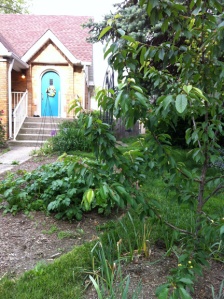
The existing vegetable bed and fruit trees (including this dwarf cherry) are just the beginning of my permaculture-inspired grand design.
Oh, I had such plans. The three fruit trees would be surrounded by guilds, and in between, I’d fit in honey berry (a vaguely blueberry-like fruiting plant), salvia to lure in insect-eating birds, and lots of zinnias and sunflowers for color. And because the average food forest is a bit wild-looking for my aesthetic tastes, I’d create tidy mulch paths through the garden and around the existing vegetable bed. And that spot directly in front of the house where I ripped the lilacs out last year? It’s a deep-mulch bed waiting to happen.
My friends, this is what winter gardening delusion looks like. It sounds great to replace all the grass with actual garden. And if I plan it correctly, I can keep the long-term maintenance to a minimum (that’s one of the benefits of a food forest). But my 30′ x 40′ front garden is still a lot of space to cover and keep weeded and mulched, especially as I’ll be doing it after full days in other people’s gardens.
And then I did the math. Say the mature width of my dwarf apple trees is 12′ (a 6′ radius around the trunk):
Area = π(r)^2, so (3.14)(6)(6)= roughly 113 sq feet per tree. That is a BIG bed, at least if you’re trying to fill three of them with new plants on a budget.
Even experienced gardeners often take on more than is smart. So this year, before I stick a shovel in the ground, I’m breaking these projects down into a timeline. This year, I will do one, maybe two of the tree guilds. And if I’m really ambitious, I may start sheet mulching that path around the vegetable garden.
But mark my words. That turf grass is going down.
